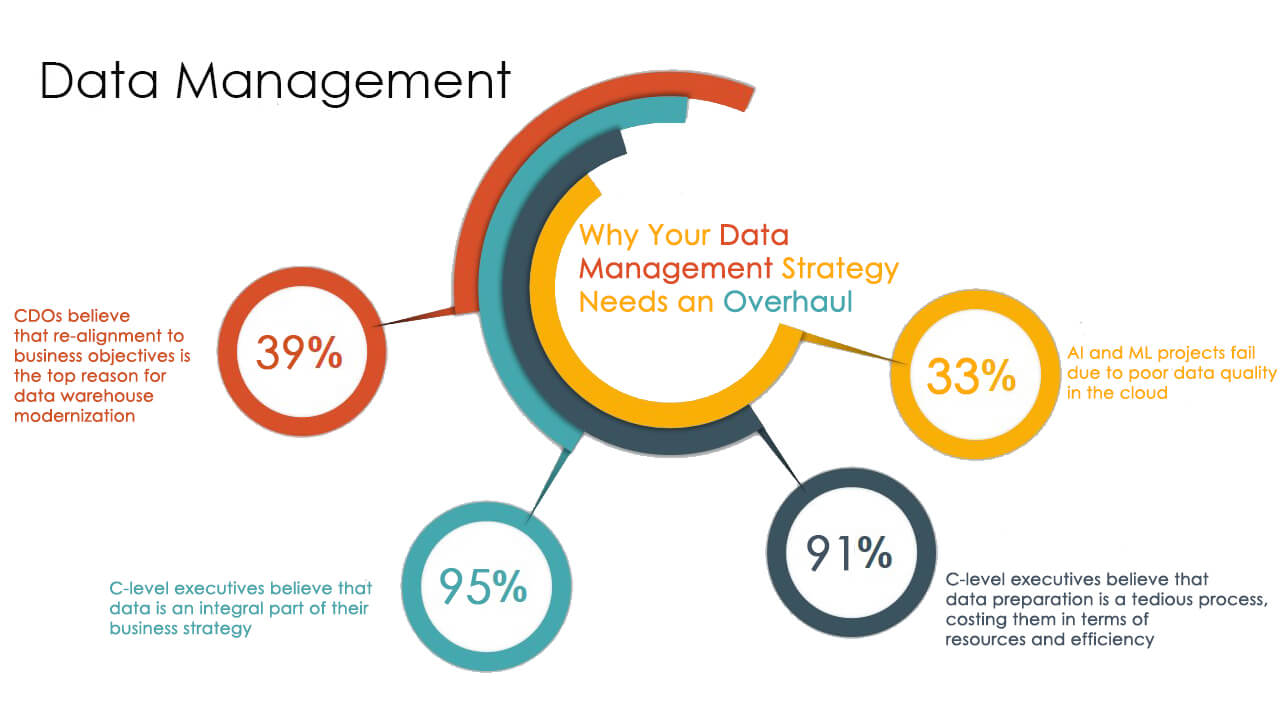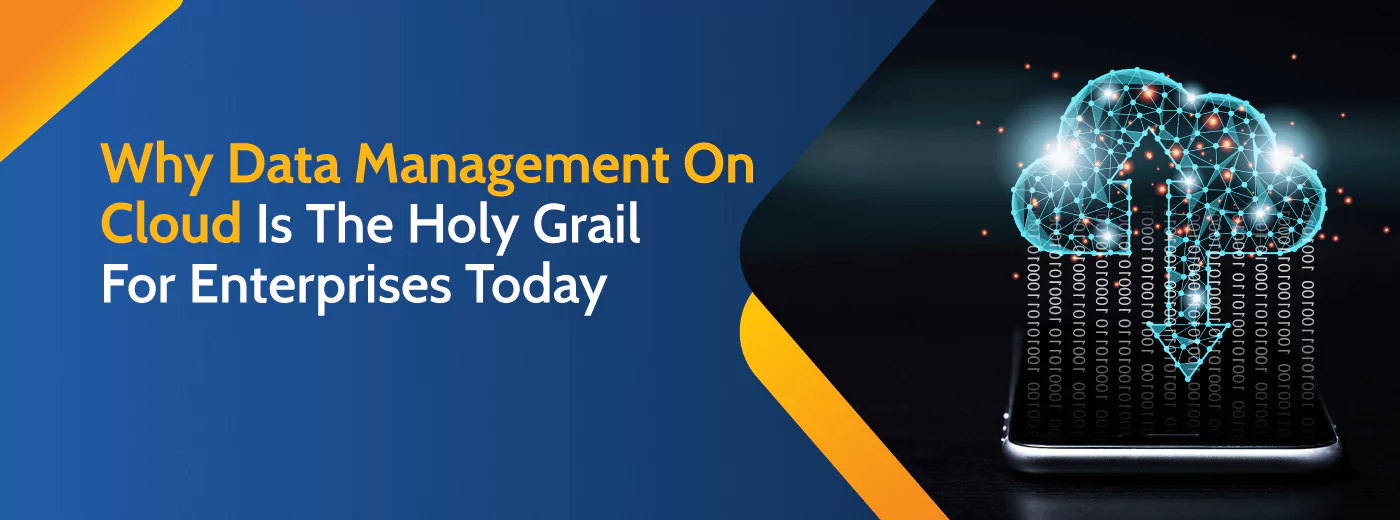Over half the Fortune 500 companies, listed from the year 2000, no longer exist. All industries around the world are experiencing digital disruption, and a cloud data management strategy is emerging as a go-to option for businesses worldwide.
A Gartner report found that while 87 percent of senior business leaders say digitalization is a company priority, only 40 percent of organizations have brought their digital initiatives to scale.
Among the reasons cited, a lack of flexible, scalable and robust data management capability is frequently explained as one of the top reasons behind why digital transformation initiatives are failing to drive the desired improvements in processes and workflows.
In this blog, we will see how cloud data management methods offer a crucial competitive advantage to enterprises today, impact cutting across industries and economies, value chains and entire value systems.
"George Moore famously quipped that without Big Data, organizations are like a stranded deer, blind and deaf in the middle of the 21st-century market freeway. Let’s delve into the analogy with the automobile: you need to design and fine-tune your engine so that it delivers superior mileage, more power output, efficient thermal design, low fuel consumption as well as feed it with high-quality fuel so that it zooms ahead on the freeway."
Likewise, when setting up your enterprise data warehouse, you need to ensure that your entire data processing engine is state of the art to remain ahead of the curve.
For this, you need a data management platform that streamlines rules for data storage and access. A sound data management strategy is a prized asset that will help enterprises realize the value from their analytics investments and will be the turbocharge to power the lean, modern, proactive and productive 21st-century enterprise, cutting costs, increasing revenues and helping pre-empt market opportunities.
In this blog, we will delve into the components of what a modern, successful data management system entails.
So, why does the need arise for a cloud data management system?
Today enterprises are deploying many use cases such as text analytics, streaming analytics, real-time social media monitoring, processing technical and functional use cases. Moreover, real-time data ingestion is increasingly being used to support critical business workloads.
Traditional data warehouses, featuring long IT cycles for design and up-gradation, is not built to support these demands since they cannot scale quickly to meet unpredictable spikes in data volume, accept an unprecedented varieties of structured and unstructured data from an ever spawning number of source systems, support big data and massive parallel processing systems, and support real-time data analytics use cases on this massive volume ( streaming data).
While the use cases will differ from industry to industry and from company to company, the verdict is unanimous - a traditional data management strategy is not built to support the modern enterprise needs with their data. Organizations need an open relationship with their data today.
Organizations are automating their data pipelines to optimize enterprise data management, including Master Data Management (MDM). The global enterprise data management market size is expected to grow from USD 77.9 billion in 2020 to USD 122.9 billion by 2025, at a CAGR of 9.5% during the forecast period 2020.
Inconsistent and inadequate data input can affect the quality of decisions. Hence, companies need to break down data silos and ensure data formatting and standardization to remove inconsistencies in the data.
"A modern cloud data management platform needs to be agile enough to use appropriate data transfer mechanisms and deliver lower latency because the users will want their analytics fast. One of Marissa Mayer, Yahoo CEO’s famous epigrams for her IT department was “With data collection, ‘the sooner the better’ is always the best answer.”
To summarize enterprises need an adaptable data warehouse design that can support the following modern use cases
1) Storing huge volumes of enterprise data- cost-effectively storing data in dumps so that they can be visited later for analysis. This requires an increased scale of ingest and scale of pre-processing
2) Real-time analytics - The solution must support and drive fast data pipelines, ingesting real-time data is becoming crucial and reduce latency for analytics applications
3) Keep unstructured and structured data together - The data management platform must work by blending both structured and unstructured data together.
4) Automated Data Pipeline - to minimize human errors and ensure minimal data duplication while supporting agile use cases
5) Data governance - A governed data governance, access and sharing framework, so that IT can ensure that data is being used appropriately.
6) Support advanced analytics use cases - Include ML/ AI capabilities with strong data governance mechanisms for monitoring the performance of models.
7) Support ad hoc requirements - Since different users will require access to the data to solve specific use cases for themselves
The Chief Data Officer needs to ensure greater alignment between the IT folks who control the data and the business team.
Ultimately, the IT team must understand the specific challenge with regard to the data that the business team is facing and come up with the right solutions and deploy cutting edge data management infrastructure to support modern workloads that will deliver a competitive edge, and increase operational efficiency, discover new revenue streams and cut costs.

Enter Cloud Data Management
Traditional data management is not sufficient to address the existing use cases. Modern elegant data solutions built using cloud computing solutions are addressing these challenges efficiently.
A cloud data management utilizes an interconnected network of Internet hosted distant servers to store, and compute information. The biggest advantage that cloud offers is that it can rapidly ingest new types of data at scale to accommodate new use cases, higher concurrency and at a faster pace.
Major cloud computing services providers, such as Azure, AWS, GCP, Snowflake, promise to completely transform the prevalent business model.
ALSO READ: BEST 4 CLOUD DATA WAREHOUSE SOLUTIONS IN 2020
Rather than having to do all the tasks by themselves - such as setting up the infrastructure, buying servers, upgrading capacity and OS, audit review, installing security patches, hiring specialists such as system engineer, network engineer, security consultant; with the cloud computing, company can quickly provision storage and compute by signing up with a service provider in minutes without worrying about operational tasks and maintenance.
On-premise solutions are often expensive to manage and maintain. With cloud computing you only pay for what you need.
The cloud serves important use cases for big data management and to serve organizational priority since memory and compute can be shrunk or grown instantaneously.
Computationally heavy tasks such as applying advanced machine learning models require large resources in terms of compute and storage power.
Hence, offloading these tasks to cloud computing, which can be scaled down or up, depending upon the requirements becomes a vital part of the strategy. The cloud offers massive scalability because it becomes easy to open an account to start using data warehouse capabilities straight away.
In the future, we expect to see more and more organizations moving towards the hybrid model - The public cloud would be used to store data, to have a number of batch processes running, to serve users who are outside the company, and to administer all the IT.
The "On-Premise" cloud, offered by most major players today, on the other hand, will have the same uses as the public cloud, but for anything that raises concerns about security (and connectivity) or performance.
Choosing The Cloud Solution
While initially, the focus for most enterprises was on migrating relatively simple applications and workloads, they can now migrate, modernize and build complex and mission-critical applications in the public cloud.
By leveraging secure and resilient compute choices for your workloads, you can use cloud computing to unleash your digital workforce and accelerate processes. But with so many cloud vendors– so how do you find the right cloud for your enterprise workloads, and at the same time avoiding complexity and sprawl?
Cloud data management makes it easy for you to rent clusters or nodes. Google and Snowflake use serverless technology, so you pay exactly for the compute and storage that you use. However, with bigger companies, it can get difficult to estimate and the storage requirements can grow to be much bigger.
Making the switch from an on-prem configuration to the cloud data warehouse isn't an easy process, and it should only be undertaken with a developed roadmap.
Such an enterprise data management will involve understanding how the old configuration manages the enterprise workloads and how the new arrangement is going to replicate/ improve those activities.
You must prioritize security, maximize access to data, optimize the data warehouse design and resource utilization. Make a well-informed execution strategy and have the right team with you
For example, when demand spikes, IT teams must keep delivering consistent user experiences; and ensure end-to-security, while keeping an audit trail of compliance with regulations.
Here, the importance of relying on a dedicated technology partner becomes important who can bring in the necessary expertise to help strategize and deliver security, reduce cost, increase flexibility and increase application development productivity to support modern business requirements.
At Polestar Solutions, we provide state of the art cloud computing services. We are leading cloud computing service providers and are partners with leading cloud vendors, such as amazon cloud computing, azure data warehouse, Cloudera, Snowflake and we bring our technology and subject matter expertise not only to help you with cutting edge deployments but also by consulting on the appropriate tech stack, depending upon your unique needs, existing infrastructure investments and future roadmaps.



